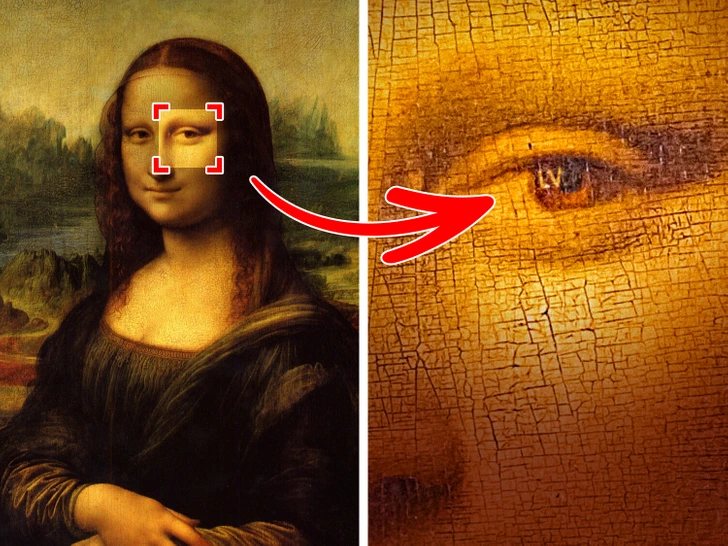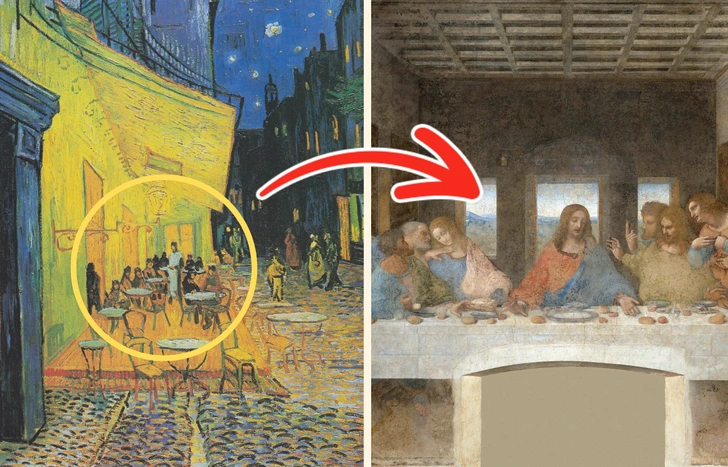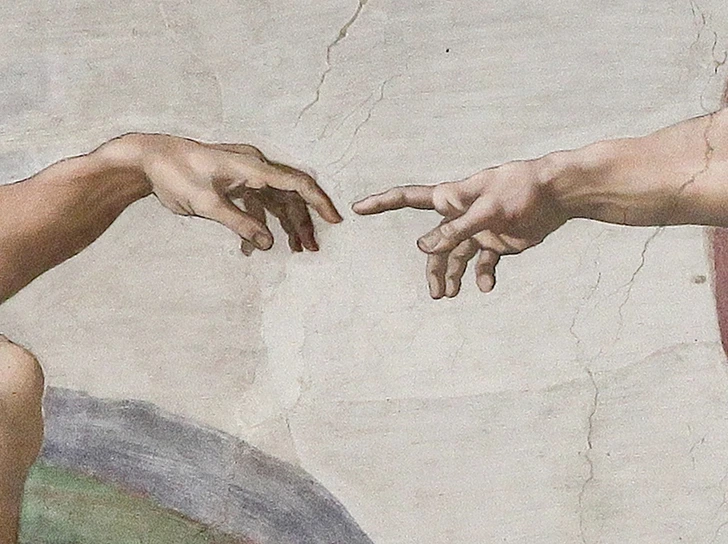Throughout the history of art, some of the most celebrated masterpieces have offered more than just aesthetic beauty—they’ve served as puzzles, provocations, and even subtle rebellions. Whether to avoid censorship, send hidden messages, or simply add layers of intrigue, many iconic artists embedded secrets in their works. Today, we take a closer look at twelve famous paintings and the fascinating mysteries tucked away within them. Get ready to view art through the eyes of a detective, because there’s often far more than meets the eye.

Michelangelo’s “The Creation of Adam,” gracing the Sistine Chapel ceiling, appears to depict God breathing life into Adam. But a closer inspection reveals a deeper secret. The shape that outlines God and the angels is eerily similar to a human brain. Michelangelo, a skilled anatomist, may have embedded this as a bold statement—that the divine spark is not just spiritual, but rooted in the human mind itself.
Leonardo da Vinci’s “The Last Supper” is not just a religious masterpiece—it’s a code waiting to be cracked. Every hand gesture, gaze, and loaf of bread carries layered meaning. Some theorists argue the figure to Jesus’s right is actually Mary Magdalene, not John. Others suggest the placement of the hands and bread hides a musical composition. Whether a theological message or a playful mystery, Da Vinci left room for interpretation—deliberately, no doubt.
In Vincent van Gogh’s “Café Terrace at Night,” the nighttime setting and starry sky suggest a peaceful scene. Yet, some scholars have proposed that the composition subtly references Da Vinci’s “Last Supper.” The central figure, with long hair, could echo Jesus, while a cross-shaped window behind him strengthens the theory. While Van Gogh wasn’t known for cryptic symbols, this scene may serve as a quiet homage.
Sandro Botticelli’s “The Birth of Venus” overflows with elegance, but its delicate beauty conceals deep symbolism. The goddess’s graceful posture and flowing hair aren’t just stylistic choices—they reflect ideals of purity and philosophical thought. Hidden in the scene are various flowers and plants, each loaded with meaning. Myrtle, associated with Venus herself, signifies love. Primroses point to spring and new beginnings, violets represent modesty and were once ingredients in love potions. Additional flora like cornflowers, irises, jasmines, and poppies each add subtle layers of meaning.
Pablo Picasso’s “The Old Guitarist,” created during his Blue Period, seems to depict sorrow and isolation. Yet X-ray analysis uncovered an unsettling truth: beneath the visible image are at least three hidden figures. Struggling financially, Picasso often reused canvases, but these ghostlike forms also seem to reflect the emotional turmoil that marked this phase of his life.
Jan van Eyck’s “The Arnolfini Portrait” may look like a formal image of a 15th-century couple, but it’s full of mystery. The small mirror in the background reflects two figures not seen in the foreground. One is possibly van Eyck himself, marking his presence in the scene. Above the mirror, the Latin phrase “Johannes de Eyck fuit hic” is inscribed, meaning “Jan van Eyck was here.” It might just be the earliest recorded case of an artist leaving a “tag” in their own work.
Edvard Munch’s “The Scream” is the visual definition of existential dread. But there’s more: scrawled faintly at the top is a chilling phrase—“Could only have been painted by a madman!” Once dismissed as graffiti added by a vandal, forensic handwriting experts later confirmed it was written by Munch himself, likely in ironic response to critics questioning his mental state.

Gustav Klimt’s “The Kiss” seems to be a golden celebration of love, but deeper interpretations suggest a complex message. The man’s robe features rigid black rectangles, while the woman’s garment is adorned with swirling patterns and floral motifs. These contrasts are often interpreted as symbols of masculine and feminine energy—possibly even yin and yang. Some see this painting as a metaphor for surrender, the merging of two souls, or even a parting embrace.
Hieronymus Bosch’s “The Garden of Earthly Delights” is a surreal, fantastical triptych that still baffles art historians. Amid its bizarre imagery of oversized fruits and hybrid creatures, one particularly peculiar detail stands out. In the hellish right panel, a character’s buttocks are tattooed with actual sheet music. Known online as “Bosch’s musical butt,” this passage was even transcribed and performed, showing Bosch’s dark humor and layered storytelling.
Leonardo da Vinci returns to the list with his most famous work, the “Mona Lisa.” Her smile isn’t her only mystery. In 2010, Italian researchers discovered tiny letters hidden in her eyes—“LV” in the right eye, presumably for Leonardo da Vinci, and still-undeciphered symbols in the left. Some believe the landscape behind her is not random but rather a concealed map. Whether or not it leads anywhere remains part of the enigma.

Rembrandt’s “The Night Watch” may look like a grand portrait of a civic militia, but its composition is more theatrical than documentary. The figures are arranged like actors on a stage. Behind the captain, almost hidden, is a girl with a dead chicken hanging from her belt. Scholars suggest the chicken represents the disbanding of the militia, though Rembrandt never confirmed it. As with many of his works, part of the appeal lies in the mystery.
Lastly, Pieter Aertsen’s “A Meat Stall with the Holy Family Giving Alms” appears at first to glorify abundance, with lavish cuts of meat and cheese in the foreground. But tucked in the background is a touching biblical scene: the Holy Family giving alms to the poor. This quiet moment contrasts sharply with the display of wealth, offering a powerful commentary on generosity and humility.
Each of these masterpieces shows that true art isn’t just what’s visible—it’s also what’s hidden. Whether these secrets were intentionally placed or the result of whimsical genius, they invite viewers to look closer, ask questions, and see beyond the surface. For those intrigued by the mysteries behind famous paintings, remember: sometimes, the most fascinating parts of a work are the ones you almost miss.





